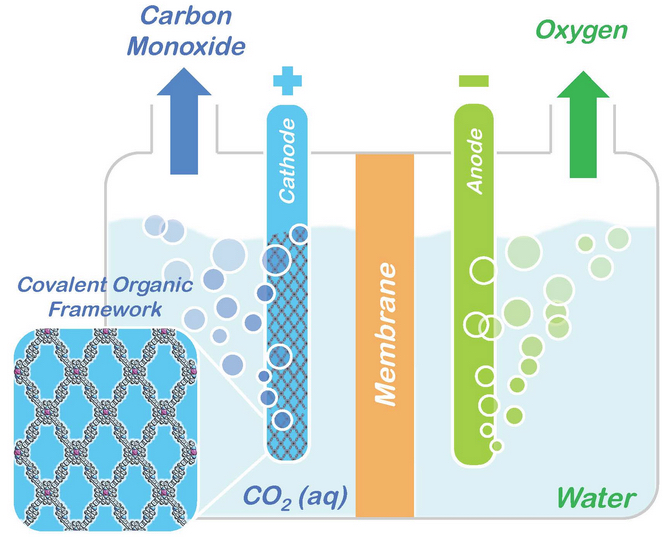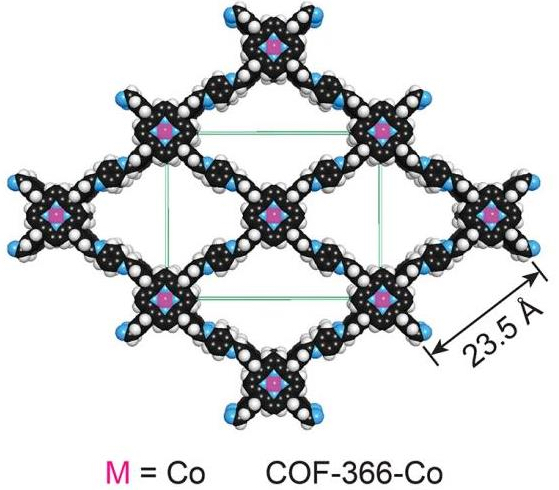Soaking up carbon dioxide and turning it into valuable products
August 31, 2015

Conceptual model showing how porphyrin COFs could be used to split CO2 into CO and oxygen (credit: Omar Yaghi, Berkeley Lab/UC Berkeley)
Researchers with the U.S. Department of Energy (DOE)’s Lawrence Berkeley National Laboratory (Berkeley Lab) have developed a system that absorbs carbon dioxide and also selectively reduces it to carbon monoxide (which serves as a primary building block for a wide range of chemical products including fuels, pharmaceuticals and plastics).
The trick: they’ve incorporated molecules of carbon dioxide reduction catalysts into the sponge-like crystals of covalent organic frameworks (COFs).
How to soak up carbon dioxide in the area of a football field
With the reduction of atmospheric carbon dioxide emissions in mind, Yaghi and his research group at the University of Michigan in 2005 designed and developed the first COFs as a means of separating carbon dioxide from flue gases. A COF is a porous three-dimensional crystal consisting of a tightly folded, compact framework that features an extraordinarily large internal surface area — a COF the size of a sugar cube were it to be opened and unfolded would blanket a football field. The sponge-like quality of a COF’s vast internal surface area enables the system to absorb and store enormous quantities of targeted molecules, such as carbon dioxide.

Structural model showing a covalent organic framework (COF) embedded with a cobalt porphyrin (credit: UC Berkeley)
“There have been many attempts to develop homogeneous or heterogeneous catalysts for carbon dioxide, but the beauty of using COFs is that we can mix-and-match the best of both worlds, meaning we have molecular control by choice of catalysts plus the robust crystalline nature of the COF,” says Christopher Chang, a chemist with Berkeley Lab’s Chemical Sciences Division, and a co-leader of this study.
“To date, such porous materials have mainly been used for carbon capture and separation, but in showing they can also be used for carbon dioxide catalysis, our results open up a huge range of potential applications in catalysis and energy.”
Chang and Omar Yaghi, a chemist with Berkeley Lab’s Materials Sciences Division who invented COFs, are the corresponding authors of a paper in Science that describes this research.
Chang and Yaghi both hold appointments with the University of California (UC) Berkeley. Chang is also a Howard Hughes Medical Institute (HHMI) investigator. Yaghi is co-director of the Kavli Energy NanoScience Institute (Kavli-ENSI) at UC Berkeley.
The notoriety of carbon dioxide for its impact on the atmosphere and global climate change has overshadowed its value as an abundant, renewable, nontoxic and nonflammable source of carbon for the manufacturing of widely used chemical products, the researchers point out.
Now, through another technique developed by Yaghi, called “reticular chemistry,” which enables molecular systems to be “stitched” into netlike structures that are held together by strong chemical bonds, the Berkeley Lab researchers were able to embed the molecular backbone of COFs with a porphyrin catalyst, a ring-shaped organic molecule with a cobalt atom at its core. Porphyrins are electrical conductors that are especially proficient at transporting electrons to carbon dioxide.
Among most efficient CO2 reduction agents
“A key feature of COFs is the ability to modify chemically active sites at will with molecular-level control by tuning the building blocks constituting a COF’s framework,” Yaghi says. “This affords a significant advantage over other solid-state catalysts where tuning the catalytic properties with that level of rational design remains a major challenge. Because the porphyrin COFs are stable in water, they can operate in aqueous electrolyte with high selectivity over competing water reduction reactions, an essential requirement for working with flue gas emissions.”
In performance tests, the porphyrin COFs displayed exceptionally high catalytic activity — a turnover number up to 290,000, meaning one porphyrin COF can reduce 290,000 molecules of carbon dioxide to carbon monoxide every second. This represents a 26-fold increase over the catalytic activity of molecular cobalt porphyrin catalyst and places porphyrin COFs among the fastest and most efficient catalysts of all known carbon dioxide reduction agents. Furthermore, the research team believes there’s plenty of room for further improving porphyrin COF performances.
“We’re now seeking to increase the number of electroactive cobalt centers and achieve lower over-potentials while maintaining high activity and selectivity for carbon dioxide reduction over proton reduction,” Chang says. “In addition we are working towards expanding the types of value-added carbon products that can be made using COFs and related frameworks.”
This research was supported by the DOE Office of Science in part through its Energy Frontier Research Center (EFRC) program. The porphyrin COFs were characterized through X-ray absorption measurements performed at Berkeley Lab’s Advanced Light Source, a DOE Office of Science User Facility.
Abstract of Covalent organic frameworks comprising cobalt porphyrins for catalytic CO2 reduction in water
Conversion of carbon dioxide to carbon monoxide and other value-added carbon products is an important challenge for clean energy research. Here, we report modular optimization of covalent organic frameworks (COFs), in which the building units are cobalt porphyrin catalysts linked by organic struts through imine bonds, to prepare a catalytic material for aqueous electrochemical reduction of CO2 to CO. The catalysts exhibit high Faradaic efficiency (90%) and turnover numbers (up to 290,000 with initial turnover frequency 9400 hours−1) at pH 7 with an overpotential of –0.55 V, equivalent to a 60-fold improvement in activity compared to the molecular cobalt complex, with no degradation over 24 hours. X-ray absorption data reveal the influence of the COF environment on the electronic structure of the catalytic cobalt centers.